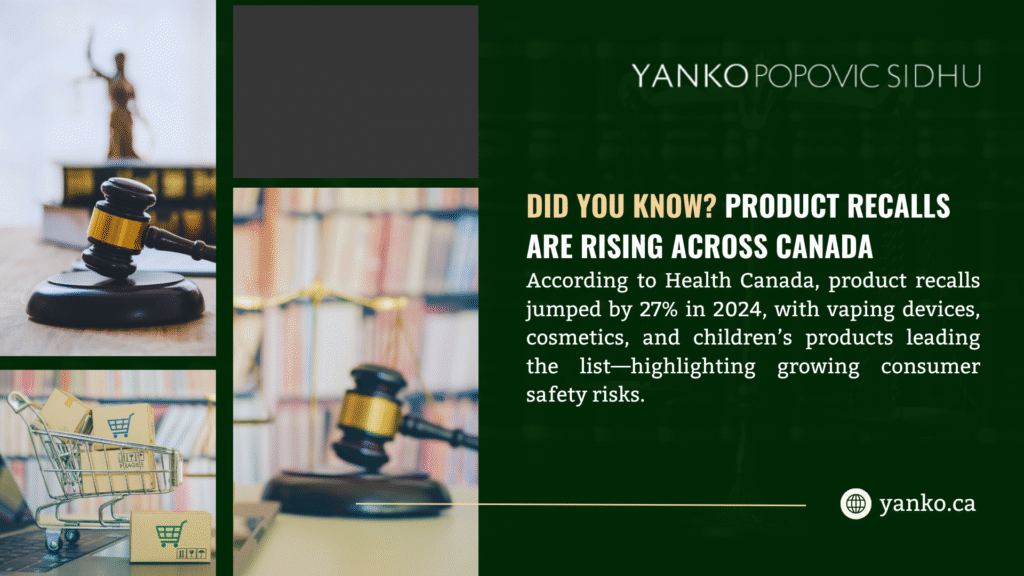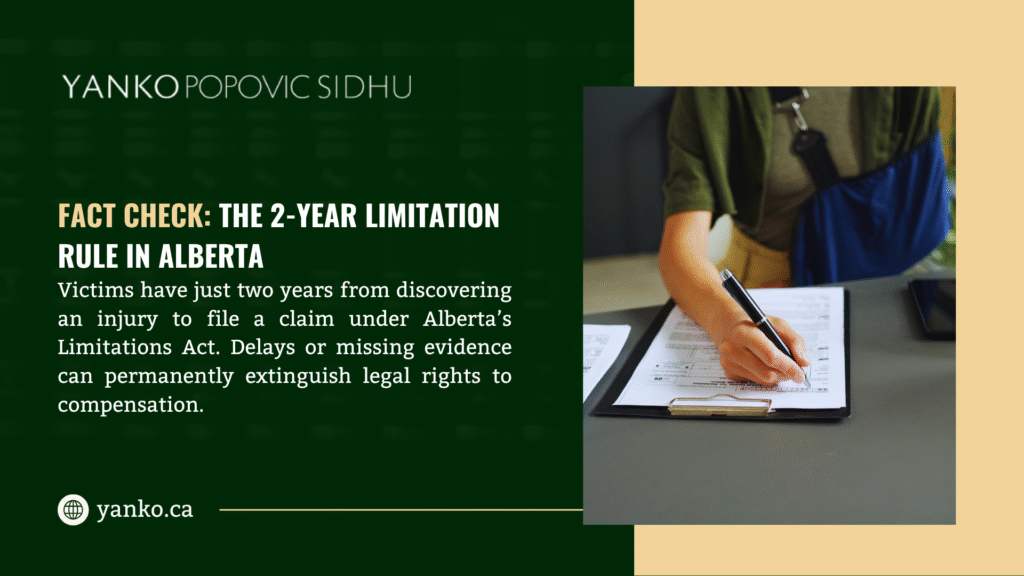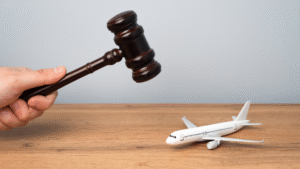Summary
| Topic | Key Insights & Data |
| Main Focus | A product liability settlement in Alberta compensates victims harmed by defective or unsafe products through negotiation before trial. |
| Legal Basis | Governed by Alberta negligence law, duty of care, breach, causation, and damages, not strict liability like in the U.S. |
| Limitation Period | 2 years from discovery of harm; 10-year ultimate cap under the Limitations Act (Alberta Queen’s Printer). |
| Average Settlement Range | Minor injuries: $25K–$90K; severe or lifelong impairments: $400K+, depending on future care and income loss. |
| Relevant Global Examples | Johnson & Johnson talc lawsuit 2024, Paraquat settlement, toxic baby food, diacetyl vapes, Roundup litigation. |
| Local Insight | Alberta requires proof of negligence in design, manufacturing, or warning; expert evidence is essential. |
| Process Timeline | 18–36 months on average (investigation → mediation → agreement). |
| Fees & Access | Yanko Popovic Sidhu operates on a no-upfront-fee model, payment only upon successful recovery. |
| Consumer Trend (2024) | According to Health Canada, product recalls rose 27% YoY, led by vaping devices, cosmetics, and children’s products. |
| Takeaway | Early legal representation maximizes settlement potential and protects limitation rights. |
The Meaning of a Product Liability Settlement in Alberta
A product liability settlement is a negotiated resolution between an injured consumer and a manufacturer, distributor, or retailer whose defective product caused harm.
Unlike many U.S. jurisdictions that apply strict liability, Alberta follows a fault-based negligence model. The injured person must show that the defendant failed to meet a reasonable standard of care in the product’s design, manufacture, testing, labeling, or warnings.
A settlement avoids trial while compensating the claimant for medical losses, income disruption, and pain. In Alberta, these agreements frequently arise after mediation or pre-trial conferences conducted under the Alberta Rules of Court, AR 124/2010
The Legal Framework: Duty, Breach, Causation, and Damage
| Element | Explanation | Example Evidence |
| Duty of Care | Manufacturers owe a duty to all foreseeable users, including warning of known risks. | Product manuals, safety inserts. |
| Breach of Standard | Failure to test, ignoring recalls, or omitting risk language constitutes a breach. | Testing logs, regulatory filings. |
| Causation and Damage | Injury must directly result from a defect decided through expert evidence. | Medical reports, engineering analysis. |
Typical Sources of Liability
| Type of Defect | Alberta Legal Test | Common Evidence |
| Design Defect | Was the design unreasonably dangerous when compared with feasible, safer alternatives? | Engineering analyses, prior incidents, and recall data |
| Manufacturing Defect | Did a deviation during production render the individual product unsafe? | Quality-control logs, batch testing, failure analysis |
| Failure to Warn / Labeling Defect | Did the manufacturer fail to disclose foreseeable hazards or proper use? | Packaging, inserts, regulatory filings, expert human-factors reports |
Alberta-Specific Rules and Limitation Periods
Under the Limitations Act, RSA 2000 c L-12, a claimant has two years from the date they knew, or should reasonably have known, that an injury resulted from the product. A ten-year ultimate limitation also applies.
Failing to preserve evidence or delaying investigation can extinguish rights entirely. This is why early consultation with a Calgary product-liability lawyer is critical.
If you believe a defective or dangerous product caused your injury, speak directly with our team at Yanko Popovic Sidhu’s Product Liability Lawyer page. We charge no upfront fees and review potential claims under strict confidentiality.
The Settlement Pathway in Alberta Product Liability Cases
In Alberta, product liability settlements progress through a series of structured stages designed to balance legal proof with negotiation leverage.
| Stage | Process Description | Key Objective / Legal Significance |
| Stage 1: Preservation and Preliminary Assessment | After an injury, counsel must secure the defective product, retain forensic engineers, and document the chain of custody. In Alberta, destroying or altering the product may constitute spoliation, weakening or invalidating the claim. | Preserve physical and documentary evidence to establish defect and causation early. |
| Stage 2: Notice and Claim Filing | A formal notice under the Rules of Court. 3.25 initiates disclosure and puts defendants, manufacturers, importers, and retailers on record. Claims are often tendered to insurers at this stage. | Trigger legal disclosure obligations and preserve limitation rights. |
| Stage 3: Discovery and Expert Exchange | Both parties exchange affidavits of records. Experts in materials science, toxicology, or biomechanics evaluate design flaws, labeling errors, or chemical exposure to prove causation. | Build the evidentiary base that supports liability and damages before negotiation. |
| Stage 4: Negotiation and Mediation | Alberta courts encourage Judicial Dispute Resolution (JDR) and private mediation to promote efficient settlements. The range of damages is informed by landmark cases such as Andrews v. Grand & Toy Alberta Ltd., [1978] 2 S.C.R. 229. | Achieve fair settlement through structured mediation informed by precedent. |
| Stage 5: Formal Agreement and Release | Once the parties agree, lawyers draft a written settlement outlining payment terms, confidentiality, and releases. Counsel ensures the release does not waive rights to future claims if injuries worsen. | Finalize legally binding terms and ensure the client’s future protection. |
Global Trends and Valuation Factors in Alberta Product Liability Settlements
Courts and insurers in Alberta evaluate product liability settlements by combining quantifiable damages with the broader market understanding of global product-liability trends. The severity of injury, permanence, loss of income, and projected future care costs weigh most heavily, but international verdicts and high-profile lawsuits often shape how local negotiations unfold.
Research shows that cross-border litigation, particularly in the United States, can influence the way Canadian insurers model risk and settlement brackets, even though Alberta law remains firmly rooted in negligence rather than strict liability.
a. Comparative Benchmarks and Settlement Value
When estimating a realistic settlement range, Alberta lawyers look not only at domestic precedents but also at the outcome of international mass-tort cases that share factual similarities. These examples provide context for how courts interpret corporate conduct, consumer warnings, and causation evidence.
| Case Context | Reported Public Settlement / Judgment | Key Takeaway for Alberta Practice |
| Johnson & Johnson Talcum Powder Litigation (U.S.) | Multi-billion-dollar global resolution effort with widely varying individual awards. | Demonstrates how cumulative failure-to-warn allegations can escalate liability internationally; reinforces the importance of adequate risk disclosure. |
| Paraquat Parkinson’s Claims (U.S.) | Ongoing MDL 3004 with confidential settlements reported in 2024. | Highlights the role of scientific proof in toxic-exposure claims; complex causation evidence can drive settlement variance. |
| Toxic Baby-Food Autism Actions (North America) | Class proceedings alleging heavy-metal contamination in infant cereals. | Emphasizes manufacturers’ duty to test ingredients and disclose contaminants; mirrors Alberta’s negligence approach. |
| Vape / Diacetyl Injury Claims | Individual suits after “popcorn-lung” findings in flavored e-liquids. | Underscores that labeling and ingredient transparency are essential in inhalation-product litigation. |
These global benchmarks don’t dictate Alberta outcomes but serve as valuation reference points. Adjusters and defense counsel recognize that public awareness of billion-dollar verdicts elsewhere can increase jury sympathy and settlement pressure locally.

b. Emerging Product Categories Shaping Canadian Litigation
Alberta lawyers closely track evolving categories of defective-product claims that have already tested courts in the United States and eastern Canada. Each highlights an area where scientific uncertainty, labeling practices, and consumer expectations converge into liability risk.
| Product Category | Issue Summary | Relevance to Alberta Product Liability Law |
| Talcum Powder & Ovarian Cancer | Long-term talc use has been linked to ovarian cancer in several lawsuits focusing on inadequate warnings. | In Alberta, plaintiffs must still prove specific causation and negligence, but the precedent underscores how failure-to-warn theories evolve. |
| Paraquat Herbicide Exposure | Agricultural workers allege Parkinson’s disease after chronic exposure to Paraquat herbicide. | Demonstrates the value of scientific expert evidence in chemical-exposure cases and the importance of labeling compliance. |
| Vaping & Diacetyl Inhalation | Reports link diacetyl and faulty vape batteries to respiratory illness and explosions. Common consumer concerns include “Is Stiiizy safe?” or “Which vapes contain diacetyl?” | Reinforces manufacturers’ ongoing duty to warn and maintain safe design for inhaled or combustible products. |
| Toxic Baby Food & Heavy Metals | Class actions allege excessive lead, arsenic, and mercury in infant foods. | Alberta courts would evaluate such claims under standard negligence tests for product testing and truthful labeling. |
| Chemical Hair Straighteners & Hormonal Risk | Suits allege reproductive harm from certain cosmetic hair treatments. | Sets precedent for ingredient-disclosure and consumer-warning obligations under Alberta’s consumer-protection framework. |
These categories share a common pattern: liability arises not just from a product’s inherent danger but from corporate silence or inadequate testing. When labeling, documentation, or safety data are incomplete, courts infer breach more readily.
c. Cross-Border Influence on Negotiation and Insurer Behaviour
Although Alberta’s legal system is independent, global litigation trends affect how insurers, adjusters, and defense counsel evaluate risk. Studies show that when U.S. courts issue record-setting awards, such as those in the Johnson & Johnson talcum powder or Paraquat actions, Canadian insurers often adjust internal reserve models to reflect potential reputational exposure.
According to CBC News (2024), the Johnson & Johnson talcum powder lawsuit became a symbol of how failure-to-warn claims can snowball into billion-dollar settlements. Alberta practitioners use that case to emphasize proactive disclosure and product-testing documentation.
Similarly, Bloomberg Law (2024) notes that the Paraquat litigation has driven chemical manufacturers to revisit labeling and storage standards, policy shifts that indirectly inform Canadian regulatory reform.
These international outcomes reshape negotiation psychology in Alberta. When a defence team knows that a similar product triggered massive compensation abroad, they approach mediation with greater caution.
Local lawyers leverage those precedents to argue that settlement today prevents reputation damage tomorrow, particularly in consumer-facing industries such as cosmetics, food, and electronics.
d. Alberta Context: Local Law, Global Awareness
While global developments frame the conversation, Alberta settlements always turn on four domestic elements: duty, breach, causation, and damage. Courts here still require concrete expert proof and measurable harm.
However, by referencing global litigation in mediation briefs, Alberta counsel add persuasive weight, showing that the product’s risk is widely recognized and that delay could invite public backlash.
A Calgary consumer injured by a defective appliance, vape battery, or cosmetic faces the same evidentiary path as plaintiffs worldwide, but within Canada’s more conservative damage framework. The key is strategic integration: use global data to inform local valuation while grounding every argument in Alberta law and precedent.
Calculating Compensation in Alberta Product Liability Settlements
| Compensation Category | Description / Coverage | Key Details & Notes |
| Special Damages | Covers documented economic losses such as medical bills, rehabilitation, prescriptions, and travel costs. | Must be proven through receipts, invoices, or medical records. |
| General Damages | Compensates for pain, suffering, and loss of amenities of life. | National cap set around $400,000 (indexed to inflation) under the Andrews Trilogy — Supreme Court of Canada. |
| Future Care Costs | Anticipated lifetime medical and assistive expenses (e.g., physiotherapy, devices, home modifications). | Requires expert life-care or medical assessment reports. |
| Loss of Earning Capacity | Compensation for permanent or partial loss of income due to disability or reduced work ability. | Calculated using actuarial and vocational expert projections. |
| Out-of-Pocket & Attendant-Care Expenses | Covers additional living costs like mobility aids, caregiver wages, or home assistance. | Usually reimbursed if directly linked to the product-related injury. |
| Contributory Negligence & Policy Limits | Adjustments based on the claimant’s partial fault or insurer coverage ceilings. | Settlements reflect both the contributory percentage and the insurer limits. |
The Role of Expert Evidence and Negotiation Dynamics in Alberta Product Liability Settlements
Expert Evidence: The Foundation
Every Alberta settlement relies on expert analysis.
- Engineers identify design/manufacturing flaws.
- Toxicologists link chemical exposure to injury.
- Economists model lost income and lifetime impact.
Under Rule 5.35, reports must include credentials and methodology. Once expert causation is established, insurers negotiate seriously—because credible experts close the gap between allegation and proof.
Negotiation and Insurer Behaviour
Insurers prefer predictable outcomes. Once liability seems likely, they calculate reserve ranges and test claimants with low initial offers.
Experienced counsel counters with data-driven briefs using precedent tables from CanLII and the Andrews Trilogy.
Alberta insight: documentation wins.
Adjusters trust medical chronologies and cost reports, not emotional statements. Organized evidence shortens negotiation time and increases payout credibility.
Regulatory Intersections
Product liability often overlaps with federal safety laws under the Canada Consumer Product Safety Act and the Food and Drugs Act.
These frameworks support civil cases when recalls arise—but recall evidence alone doesn’t guarantee compensation.
Settlement Strategy from a Calgary Perspective
Reaching a fair product liability settlement in Alberta depends as much on preparation as on the strength of the claim itself.
Lawyers at Yanko Popovic Sidhu approach every negotiation with a meticulous file structure that meets Alberta court expectations and insurer review standards.
Each settlement brief prepared in Calgary follows a consistent format that demonstrates both credibility and professionalism. It typically includes:
| Document Type | Purpose | How It Strengthens the Case |
| Chronology of Events | Maps the sequence from purchase to injury, establishing causation and timeline consistency. | Helps insurers and mediators visualize when and how the product failed. |
| Medical Summary | Outlines diagnosis, treatment progress, and prognosis based on healthcare records. | Quantifies the medical impact and future care needs. |
| Economic Loss Analysis | Details past income loss and projected earning-capacity reduction. | Supports actuarial valuation and justifies compensation demands. |
| Comparable Case Awards | Refers to past Alberta decisions and analogous injury valuations (from public case databases). | Anchors negotiation figures within judicial precedent. |
| Product Evidence Portfolio | Includes photographs, recall notices, and expert failure analyses. | Provides persuasive, visual proof of defect and negligence. |
These organized materials form the foundation of productive mediation. A well-documented file signals to insurers that the claimant’s counsel is prepared for trial, often prompting serious settlement discussions before reaching court.
Our firm has represented injury victims across Southern Alberta for over four decades, combining award-winning service with a no-fee-until-recovery policy.

Settlement Valuation in Depth
Determining the value of a product liability settlement in Alberta requires a disciplined economic and medical analysis. Because every injury is unique, Alberta courts avoid mechanical formulas. Instead, they weigh concrete evidence under the precedent-based approach outlined in Lindal v. Lindal, [1981] 2 S.C.R. 629.
a. Economic Losses
Economic loss is usually the largest component of compensation. The calculation includes:
| Category | Description | Example Evidence |
| Past income loss | Time off work directly caused by injury | T-4 slips, payroll summaries |
| Future earning capacity | Permanent disability or reduced hours | Vocational assessment, economist report |
| Medical & rehab costs | Treatments not covered by AHS or benefits | Receipts, physician letters |
| Out-of-pocket expenses | Travel, home modifications, assistive devices | Invoices, contractor quotes |
Insurers often apply discount rates (2 – 3 %) for future losses. Skilled counsel negotiates to minimize that discount, arguing that inflation erodes purchasing power faster than statutory rates reflect.
b. Non-Economic Damages
“Pain and suffering” in Alberta is capped by the Andrews Trilogy of Supreme Court cases. Indexed to inflation, the cap sits around $430,000 as of 2025. Plaintiffs with catastrophic injuries, spinal-cord or brain damage, approach that ceiling. Most settlements fall far below, but lawyers use those precedents to argue for proportional awards.
c. Future Care and Structured Settlements
Long-term injuries justify life-care plans prepared by rehabilitation experts. These reports estimate physiotherapy, assistive devices, and attendant-care costs over decades. Defendants sometimes propose structured settlements, periodic payments funded through annuities, to control cash-flow risk. Alberta courts will approve structures only if the plaintiff receives equivalent or better present value.
Defenses Commonly Raised by Manufacturers
Alberta defendants employ predictable strategies to cut settlement value:
| Defense Strategy | What It Means | How Experienced Counsel Counters It |
| Product Misuse | The defendant claims the consumer ignored safety labels, altered the product, or used it improperly. | Present clear usage documentation, witness statements, and expert analysis proving normal or foreseeable use. |
| Intervening Cause | Responsibility is shifted to a third party, such as a retailer, installer, or repair technician. | Trace the chain of distribution, obtain maintenance records, and show defect existed before third-party involvement. |
| Compliance Defense | The manufacturer argues that following federal or industry regulations satisfies its duty of care. | Demonstrate that compliance sets only a minimum standard and that reasonable testing or additional warnings are still required. |
| Limitation Expiry | The defendant asserts the claim was filed after the two years under Alberta’s Limitations Act. | Show the date of discovery of harm and maintain detailed evidence proving timely action. |
| Lack of Medical Causation | The defense introduces alternate medical opinions to question the link between defect and injury. | Retain credible medical experts early and build a consistent causation narrative supported by records and research. |
An experienced litigator anticipates these tactics and neutralizes them through early expert retention and detailed record-keeping.
Comparative Insight: Medical-Product Negligence
Some defective products blur the line between consumer goods and medical devices. Examples include prosthetics, implants, and prescription drugs. Alberta courts apply the same negligence test but interpret “duty to warn” more stringently because human health is at stake.
If your injury arose from a faulty implant, medication, or medical device, visit our Medical Malpractice Lawyer Calgary page for detailed guidance on how professional and product negligence intersect under Alberta law.
The Negotiation Table: How Insurers Evaluate Risk
Insurance adjusters quantify exposure by balancing three numbers:
| Factor | Definition | Strategic Lever |
| P – Probability of plaintiff’s success | Based on evidence and precedent | Strong expert evidence raises P |
| D – Estimated damages if liability proven | Medical + economic + general damages | Life-care plans expand D |
| C – Cost of defense | Legal fees, experts, and potential bad faith | Lengthy discovery increases C |
The expected payout = (P × D) + C.
When that expected figure approaches or exceeds the policy limit, the insurer recommends settlement. Plaintiffs’ counsel exploit this formula by amplifying credible D and P values through detailed documentation and credible expert testimony.
Mediation, Confidentiality, and Enforcement
According to Alberta Courts Administration (2024), mediation clauses are now a standard feature in modern product liability settlements. Under the Alberta Rules of Court, r. 4.16, judges may direct the parties to attend pre-trial mediation before proceeding to trial.
These sessions are confidential, and any statements or admissions made cannot later be introduced as evidence in court. Once both sides sign the mediation agreement, it becomes legally enforceable as a binding contract. Should a defendant fail to complete payment as agreed, the plaintiff may register the unpaid balance as a judgment with the Alberta courts.
Most Alberta product liability settlements conclude within 18 to 36 months of filing. Catastrophic injury cases, especially those involving multi-defendant chains, can last several years.
Ethical and Regulatory Oversight
According to the Law Society of Alberta Code of Conduct (2025), lawyers who handle contingency-fee cases must adhere to strict professional and ethical standards. Under Rule 3.6-2, legal fees may only be deducted after recovery is obtained for the client, ensuring that injured parties face no upfront financial burden.
Clients must also receive a detailed, itemized statement of all disbursements and deductions, promoting full transparency. This approach safeguards client trust and minimizes post-settlement disputes regarding payment or costs.
Local Example: Alberta Consumer Appliance Fire
| Case Element | Details |
| Incident Overview | A Calgary family’s kitchen appliance caught fire due to an internal wiring defect. The malfunction caused structural damage and smoke-related injuries. |
| Cause of Defect | Expert engineers traced the wiring fault to a foreign manufacturer responsible for assembly and electrical testing. |
| Defendant’s Argument | The insurer denied full liability, claiming the consumer had modified or improperly maintained the appliance. |
| Resolution Process | The matter proceeded to mediation, where both parties negotiated a confidential product liability settlement. |
| Compensation Covered | Structural repairs, medical expenses for smoke inhalation, and lost wages during recovery. |
| Legal Insight | Demonstrates Alberta’s negligence model: the plaintiff must prove (1) the defect existed, (2) the product was used within its expected range, and (3) the defect directly caused the injury. |
Understanding Confidentiality and Public Interest
Defendants often demand strict confidentiality. Alberta courts respect privacy but may void clauses that conceal matters of public safety. If a defect poses continuing danger, disclosure obligations override secrecy.
For plaintiffs, confidentiality can be double-edged: it speeds resolution but suppresses deterrence value. Counsel must weigh both.
Interaction with Class Actions and Multi-District Litigation
While Alberta actions are individual, residents may join Canadian class proceedings filed in other provinces. A well-known example is the Johnson & Johnson talc MDL 2738 update in U.S. federal court, mirrored by Canadian class filings in B.C. and Quebec. Plaintiffs in Alberta coordinate through liaison counsel to share discovery.
Joining a national class can distribute costs but reduce control. Individual lawsuits may achieve faster, confidential settlements when damages are high.
Product Recalls and the Alberta Marketplace
| Legal Reference | Practical Effect for Plaintiffs | Key Limitation |
| Consumer Product Safety Act, s. 14 | Manufacturers and importers must promptly report any discovered hazards or defects to Health Canada. | Failure to report can trigger penalties, but does not itself establish civil liability. |
| Health Canada Recall Notices | Recalls—such as the 2023 e-cigarette battery recall or 2024 children’s toy lead-paint alert- can be used as supporting evidence of a defect. | A recall only confirms the existence of a defect; it does not guarantee compensation. |
| Civil Claim Requirements | Plaintiffs must still prove personal injury, causation, and financial loss to recover damages in Alberta. | Without medical and economic evidence, even recalled-product claims may fail. |
Settlement Payment Structures
According to Justice Canada, section 148(10) of the Income Tax Act permits the use of structured settlements in personal injury and product liability cases. The choice between a lump-sum payment and a structured settlement can significantly affect the long-term value of compensation.
| Structure Type / Element | Description | Key Legal or Financial Consideration |
| Lump-Sum Payment | Provides the claimant with full compensation immediately after settlement. Offers flexibility but places responsibility for investment management and tax exposure on the recipient. | Investment returns on the lump sum may be taxable, reducing net value over time. |
| Structured Settlement | Delivers scheduled, tax-free payments over a fixed period or lifetime, usually funded by a life-insurance company annuity. | Protected under Income Tax Act, s. 148(10), ensuring predictable, secure income. |
| Indexing for Inflation | Payments can be tied to the Consumer Price Index (CPI) to maintain real purchasing power in long-term care scenarios. | Experienced counsel negotiate CPI-linked escalators during mediation or drafting. |
| Security of Payments | Most structures are underwritten by federally regulated insurers, guaranteeing solvency and payment continuity. | Adds financial stability and protects the claimant against market fluctuations. |
A skilled Alberta personal-injury lawyer will evaluate both short-term liquidity needs and long-term security before advising on the optimal structure for a product liability settlement.
Post-Settlement Obligations
According to Alberta Health Services’ Recovery Program (2024), when settlement funds are released, plaintiffs are legally required to address medical liens, such as hospital or treatment cost recoveries, under section 60 of the Hospitals Act.
Experienced lawyers coordinate direct repayment of these amounts immediately after settlement to prevent future collection action or interest accrual.
In Alberta, transparency is essential at this stage. Law firms must provide a trust-account disbursement statement that itemizes every deduction, ensuring clients know precisely how the final amount is distributed. This practice not only fulfills ethical obligations but also builds long-term client trust.

Broader Policy Considerations
Research shows that product liability law in Alberta aims to strike a careful balance between consumer protection and business innovation. Overly aggressive litigation can discourage product development, while weak regulation endangers the public.
Alberta’s negligence-based model maintains that middle ground; it holds manufacturers accountable for proven wrongdoing without punishing legitimate industry effort.
Regulatory updates often follow lessons learned from major product controversies such as talcum powder, Paraquat, and vaping products. Through ongoing collaboration between Health Canada and the CSA Group, labeling standards, material testing, and product recall procedures continue to evolve, translating court experience into stronger consumer safety frameworks across Canada.
Choosing Counsel in Alberta
According to professional reviews within Alberta’s legal community, experience matters far more than advertising in personal injury and product liability cases. When choosing representation, clients should consider:
| What to Look For | Why It Matters |
| Decades of Focused Personal-Injury Practice | Deep familiarity with Alberta statutes, precedent, and insurer tactics ensures stronger negotiation outcomes. |
| Proven Trial & Settlement Record | Demonstrates capability to handle both complex litigation and early resolution effectively. |
| Transparent Contingency-Fee Agreements | Confirms clients pay only upon successful recovery, critical for financial accessibility. |
| Access to Expert Witnesses | Medical, engineering, and economic specialists strengthen causation and valuation evidence. |
| Reputation and Awards | Community recognition, including Consumer Choice Awards (earned annually since 2014 by Yanko Popovic Sidhu), reflects credibility and trustworthiness. |
Yanko Popovic Sidhu has represented Albertans for more than 40 years, securing substantial compensation for injury victims across Calgary and Southern Alberta. Learn more about our work and approach by visiting our Dangerous Product Attorney page.
Final Thoughts: The Realities of Product Liability Settlements
A product liability settlement is not simply about numbers; it’s about accountability, closure, and restoring normalcy after a preventable injury. Whether harm stems from a defective household appliance, a misbranded cosmetic, or a contaminated food product, Alberta’s courts rely on the same three pillars of justice:
- Prove negligence through credible expert evidence.
- Quantify losses using verifiable economic and medical data.
- Negotiate based on facts, not emotion.
Recent high-profile cases such as the Johnson & Johnson talcum powder lawsuit (2024), the Paraquat class action, and toxic baby food settlements have drawn international attention. Yet, within Alberta’s measured legal environment, justice is delivered quietly, through disciplined negotiation, expert advocacy, and an unwavering commitment to fairness.
If you or your family have been harmed by a defective or dangerous product, reach out to Yanko Popovic Sidhu for a confidential consultation. Visit our Product Liability Lawyer page to begin your case review. No upfront fees, no hidden costs, just focused legal representation dedicated to achieving real results.






